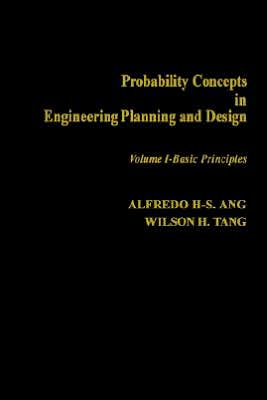

 |

|

Sold Out
Book Categories |
1. Role of Probability in Engineering
1.1. Introduction
1.2. Uncertainty in Real-World Information
1.2.1. Uncertainty Associated with Randomness
1.2.2. Uncertainty Associated with Imperfect Modeling and Estimation
1.3. Design and Decision-Making Under Uncertainty
1.3.1. Planning and Design of Airport Pavement
1.3.2. Hydrologic Design
1.3.3. Design of Structures and Machines
1.3.4. Geotechnical Design
1.3.5. Construction Planning and Management
1.3.6. Photogrammetric, Geodetic, and Surveying Measurements
1.4. Control and Standards
1.5. Concluding Remarks
2. Basic Probability Concepts
2.1. Events and Probability
2.1.1. Characteristics of Probability Problems
2.1.2. Calculation of Probability
2.2. Elements of Set Theory
2.2.1. Definitions
2.2.2. Combination of Events
2.2.3. Operational Rules
2.3. Mathematics of Probability
2.3.1. Basic Axioms of Probability; Addition Rule
2.3.2. Conditional Probability; Multiplication Rule
2.3.3. Theorem of Total Probability
2.3.4. Bayes' Theorem
2.4. Concluding Remarks
Problems
3. Analytical Models of Random Phenomena
3.1. Random Variables
3.1.1. Probability Distribution of a Random Variable
3.1.2. Main Descriptors of a Random Variable
3.2. Useful Probability Distributions
3.2.1. The Normal Distribution
3.2.2. The Logarithmic Normal Distribution
3.2.3. Bernoulli Sequence and the Binomial Distribution
3.2.4. The Geometric Distribution
3.2.5. The Negative Binomial Distribution
3.2.6. The Poisson Process and Poisson Distribution
3.2.7. The Exponential Distribution
3.2.8. The Gamma Distribution
3.2.9. The HypergeometricDistribution
3.2.10. The Beta Distribution
3.2.11. Other Distributions
3.3. Multiple Random Variables
3.3.1. Joint and Conditional Probability Distributions
3.3.2. Covariance and Correlation
3.3.3. Conditional Mean and Variance
3.4. Concluding Remarks
Problems
4. Functions of Random Variables
4.1. Introduction
4.2. Derived Probability Distributions
4.2.1. Function of Single Random Variable
4.2.2. Function of Multiple Random Variables
4.3. Moments of Functions of Random Variables
4.3.1. Introduction
4.3.2. Mean and Variance of a Linear Function
4.3.3. Product of Independent Variates
4.3.4. Mean and Variance of a General Function
4.4. Concluding Remarks
Problems
5. Estimating Parameters from Observational Data
5.1. The Role of Statistical Inference in Engineering
5.1.1. Inherent Variability and Estimation Error
5.2. Classical Approach to Estimation of Parameters
5.2.1. Random Sampling and Point Estimation
5.2.2. Interval Estimation of the Mean
5.2.3. Problems of Measurement Theory
5.2.4. Interval Estimation of the Variance
5.2.5. Estimation of Proportion
5.3. Concluding Remarks
Problems
6. Empirical Determination of Distribution Models
6.1. Introduction
6.2. Probability Paper
6.2.1. The Normal Probability Paper
6.2.2. The Log-Normal Probability Paper
6.2.3. Construction of General Probability Paper
6.3. Testing Validity of Assumed Distribution
6.3.1. Chi-Square Test for Distribution
6.3.2. Kolmogorov-Smirnov Test for Distribution
6.4. Concluding Remarks
Problems
7. Regression and Correlation Analyses
7.1. Basic Formulation of Linear Regression
7.1.1. Regression with Constant Variance
7.1.2. Regression with Nonconstant Variance
7.2. Multiple Linear Regression
7.3. Nonlinear Regression
7.4. Applications of Regression Analysis in Engineering
7.5. Correlation Analysis
7.5.1. Estimation of Correlation Coefficient
7.6. Concluding Remarks
Problems
8. The Bayesian Approach
8.1. Introduction
8.2. Basic Concepts--The Discrete Case
8.3. The Continuous Case
8.3.1. General Formulation
8.3.2. A Special Application of Bayesian Up-dating Process
8.4. Bayesian Concepts in Sampling Theory
8.4.1. General Formulation
8.4.2. Sampling from Normal Population
8.4.3. Error in Estimation
8.4.4. Use of Conjugate Distributions
8.5. Concluding Remarks
Problems
9. Elements of Quality Assurance and Acceptance Sampling
9.1. Acceptance Sampling by Attributes
9.1.1. The Operating Characteristic (OC) Curve
9.1.2. The Success Run
9.1.3. The Average Outgoing Quality Curve
9.2. Acceptance Sampling by Variables
9.2.1. Average Quality Criterion, σ Known
9.2.2. Average Quality Criterion, σ Unknown
9.2.3. Fraction Defective Criterion
9.3. Multiple-Stage Sampling
9.4. Concluding Remarks
Problems
Appendix A. Probability Tables
Table A.1. Table of Standard Normal Probability
Table A.2. p-Percentile Values of the t-Distribution
Table A.3. p-Percentile Values of the x2-Distribution
Table A.4. Critical Values of Dα in the Kolmogorov-Smirnov Test
Appendix B. Combinatorial Formulas
Appendix C. Derivation of the Poisson Distribution
References
Index
Login|Complaints|Blog|Games|Digital Media|Souls|Obituary|Contact Us|FAQ
CAN'T FIND WHAT YOU'RE LOOKING FOR? CLICK HERE!!! X
 You must be logged in to add to WishlistX
 This item is in your Wish ListX
 This item is in your CollectionProbability Concepts in Engineering Planning and Design
X
 This Item is in Your InventoryProbability Concepts in Engineering Planning and Design
X
 You must be logged in to review the productsX
 X
 X

Add Probability Concepts in Engineering Planning and Design, A comprehensive treatment of essential probability concepts necessary and useful for engineering planning and design under conditions of uncertainty. Treats application of modern probability concepts at the elementary level., Probability Concepts in Engineering Planning and Design to the inventory that you are selling on WonderClubX
 X

Add Probability Concepts in Engineering Planning and Design, A comprehensive treatment of essential probability concepts necessary and useful for engineering planning and design under conditions of uncertainty. Treats application of modern probability concepts at the elementary level., Probability Concepts in Engineering Planning and Design to your collection on WonderClub |